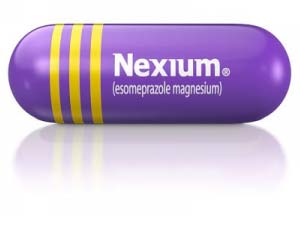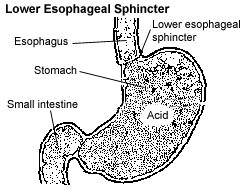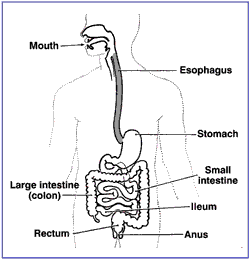Comparison of online pharmacies by Drug: Generic Nexium (Esomeprazole)
What is Nexium?

Esomeprazole (chemical name) Pronunciation: (ess-oh-MEP-ra-zole)
Nexium (brand name)
Esomeprazole (Nexium) is available with a doctor’s prescription and is commonly called by its brand name, Nexium.
Nexium belongs to a group of drugs called proton pump inhibitors (PPIs).
Other drugs in the same class include:
omeprazole (Prilosec)
lansoprazole (Prevacid)
rabeprazole (Aciphex)
pantoprazole (Protonix)
Chemically, esomeprazole (Nexium) is very similar to omeprazole (Prilosec).
Proton pump inhibitors reduce the production of acid in the stomach and intestines by blocking the enzyme in the wall of the stomach that produces acid. Decreasing stomach acid can help ulcers to heal and reflux, or heartburn symptoms to subside.
Nexium is used to treat gastroesophageal reflux disease (GERD or heartburn), erosive esophagitis, and other conditions involving excessive stomach acid production. The FDA also approved Nexium, in combination with two antibiotics, amoxicillin, and clarithromycin, to treat Helicobacter pylori (H. pylori) infection, which is responsible for the majority of gastric and duodenal ulcers. It may also be used to treat other conditions as determined by your doctor.
The stomach produces hydrochloric acid (HCl) when you eat something. On average, the stomach produces 2 liters of HCl daily. In the stomach, your food is broken down by the stomach acids in preparation for digestion. When we eat such things as bread, meat, and vegetables, they are not in a form that the body can use as nourishment. Our food and drink must be changed into smaller molecules of nutrients before they can be absorbed into the blood and carried to cells throughout the body. Digestion is the process by which food and drink are broken down into their smallest parts so that the body can use them to build and nourish cells and to provide energy.
The esophagus is the tube that connects the throat to the stomach. It carries food, liquids, and saliva from the mouth to the stomach. A ringlike valve at the bottom of your esophagus called the lower esophageal sphincter (LES), prevents reflux (or backing up) of acid. The lower esophageal sphincter (LES) usually remains closed. It relaxes during swallowing to allow food to pass into the stomach. It then tightens to prevent flow in the opposite direction.
Gastroesophageal Reflux
If the lower esophageal sphincter (LES) stays relaxed more frequently than normal, acid and food particles seep out of the stomach and up into the esophagus. This is called gastroesophageal reflux. When gastroesophageal reflux symptoms worsen or are severe enough to cause more serious problems, it is then a disease called Gastroesophageal Reflux Disease or GERD.
In some people, this can cause Esophagitis. Esophagitis is an inflammation of the lining of the esophagus. This condition is called Erosive Esophagitis (EE). Only a doctor can determine if you have this damage. Erosive Esophagitis is one of the more serious forms of gastroesophageal reflux disease (GERD) If left untreated, the acid from the stomach can wear away or erode the lining of your esophagus.
Esophageal damage caused by GERD may lead to even more serious complications, including stricture, hemorrhage, a precancerous condition known as Barrett’s esophagus, and esophageal cancer.
Other Causes of Esophagitis:
Certain infections, such as fungus infection (monilia, candida) and viruses, can occur in the esophagus and cause inflammation. Irradiation and caustic substances, like lye, also can cause esophagitis. Acid reflux from the stomach, however, is the most common cause of the condition.
The proton pump inhibitor, Nexium, blocks the formation of acid in the stomach, which can then help heal erosive esophagitis and relief of heartburn symptoms due to gastroesophageal reflux disease.
Your results may vary depending on the dosage your doctor prescribes. Nexium comes in 20mg and 40mg Delayed-Release capsules.
Nexium Drug Interactions
Some medicines or medical conditions may interact with Nexium. When any drug is prescribed, the possibility of drug interactions should always be considered. Tell your doctor or pharmacist of all the prescription and nonprescription drugs that you are taking, especially:
- Digoxin
- Diazepam
- Ketoconazole
- Itraconazole
- Sucralfate
- Iron supplements
- Vitamins with iron
- Cilostazol
Tell your doctor your medical history, especially liver disease, and any allergies you may have, or if you are pregnant or breastfeeding.
Drugs other than those listed here may also interact with Nexium.
Nexium Dosage
Nexium is available in 20 mg and 40 mg Delayed-Release capsules.
Recommended adult dosage for treatment of erosive esophagitis is Nexium 20 mg or Nexium 40 mg one capsule daily 4 to 8 weeks (unless otherwise directed by your doctor). If healing is not complete, Nexium can be given for another 4 to 8 weeks. For maintenance of healing, the recommended dosage is Nexium 20 mg once daily. Controlled studies have not extended beyond 6 months.
To treat symptoms of Gerd in the absence of erosive disease, Nexium 20 mg once daily for 4 weeks, is recommended: an additional 4 weeks of treatment may be considered if symptoms persist.
For eradication of H. pylori to reduce the risk of duodenal ulcer recurrence, 10 days of triple therapy with Nexium (esomeprazole) 40 mg once daily, amoxicillin 1000 mg twice daily and clarithromycin 500 mg twice daily is recommended.
No dosage adjustment is necessary for patients with mild to moderate hepatic impairment; for patients with severe hepatic impairment, the dose of Nexium (esomeprazole) should not exceed 20 mg.
Follow the directions for using Nexium provided by your doctor.
Directions:
Nexium capsules should be taken by mouth at least one hour before food and at the same time every day unless otherwise directed by your doctor.
Do not crush or chew the Nexium capsule. SWALLOW THE CAPSULE WHOLE. If you have difficulty swallowing capsules whole, you can empty a Nexium capsule into soft food such as a tablespoon of cool applesauce or yogurt. (The applesauce should not be hot). Do not chew the applesauce or yogurt medication mixture or make up a supply in advance. After taking the drug/applesauce mixture, drink a glass of cool water to ensure complete swallowing of the medicine. The applesauce should be eaten IMMEDIATELY and never stored for later use. The pellets should not be chewed or crushed.
If You Miss A Dose:
If you miss a dose of Nexium, use it as soon as you remember. If it is near the time of the next dose, skip the missed dose and resume your usual dosing schedule. DO NOT double the dose to catch up.
Your doctor will prescribe the dose that is right for you.
Nexium should be stored at room temperature between 59 and 86 degrees F (15 and 30 degrees C) in a tightly closed container, away from heat, light, and moisture. Do not store Nexium in the bathroom.
If You Take Too Much:
If an overdose of Nexium is suspected, contact your local poison control center or emergency room immediately. Symptoms of overdose may include confusion, drowsiness, unusual sweating, blurred vision, or unusually fast heartbeat.
Additional Information:
If you are taking Nexium for gastric ulcers or gastroesophageal reflux disease, your symptoms should improve within 4 to 8 weeks. An additional 4 weeks of treatment may be considered. If your symptoms do not improve or if they become worse, contact your doctor.
DO NOT SHARE NEXIUM with others for whom it was not prescribed. DO NOT USE Nexium for other health conditions (unless otherwise directed by your doctor) KEEP Nexium out of the reach of children and pets. IF USING NEXIUM FOR AN EXTENDED PERIOD OF TIME, obtain refills before your supply runs out.
Nexium Side Effects
headache
diarrhea
constipation
nausea
gas
dry mouth
stomach pain
or cough may occur
If any of these side effects continue or worsen, notify your doctor.
Tell your doctor IMMEDIATELY if any of these serious side effects occur:
throat pain
chest pain
severe stomach pain
or coffee-ground vomit
An allergic reaction to Nexium is unlikely, but seek immediate medical attention if it occurs. Symptoms of an allergic reaction include:
rash
itching
swelling
dizziness
trouble breathing
If you notice other side effects not listed above, contact your doctor, nurse, or pharmacist.
Definitions
Hydrochloric Acid (HCl)
(hy-droh-KLOR-ik ASS-id)
An acid made in the stomach. Hydrochloric acid works with pepsin and other enzymes to break down proteins.
Lower Esophageal Sphincter
(LOH-wur uh-saw-fuh-JEE-ul SFEENK-tur)
The muscle between the esophagus and stomach. When a person swallows, this muscle relaxes to let food pass from the esophagus to the stomach. It stays closed at other times to keep stomach contents from flowing back into the esophagus.

Digestive System
(dy-JES-tuv sis-tum)
The organs in the body that break down and absorb food. Organs that make up the digestive system are the mouth, esophagus, stomach, small intestine, large intestine, rectum, and anus. Organs that help with digestion but are not part of the digestive tract are the tongue, glands in the mouth that make saliva, pancreas, liver, and gallbladder.
Esophagitis
(eh-saw-fuh-JY-tis)
An irritation of the esophagus, usually caused by acid that flows up from the stomach.
Esophagus
(eh-SAW-fuh-gus)
The organ that connects the mouth to the stomach. Also called gullet.
Liver
(LIH-vur)
The largest organ in the body. The liver carries out many important functions, such as making bile, changing food into energy, and cleaning alcohol and poisons from the blood.
Bile
(BY-ul)
Fluid made by the liver and stored in the gallbladder. Bile helps break down fats and gets rid of wastes in the body.
Gallbladder
(GAWL-blah-dur)
The organ that stores the bile made in the liver. Connected to the liver by bile ducts. The gallbladder can store about 1 cup of bile. Eating signals the gallbladder to empty the bile through the bile ducts to help digest fats.
Pancreas
(PAN-kree-ahs)
A gland that makes enzymes for digestion and the hormone insulin.
Small Intestine
Organ where most digestion occurs. It measures about 20 feet and includes the duodenum, jejunum, and ileum.
Duodenum
(doo-AW-duh-num)
The first part of the small intestine.
Gastroesophageal Reflux Disease (GERD)
Nexium is used to treat gastroesophageal reflux disease (GERD or heartburn), erosive esophagitis, and other conditions involving excessive stomach acid production.
Gastroesophageal reflux is the backflow of acid and food particles that seep out of the stomach and up into the esophagus. This happens when the muscle between the esophagus and the stomach (the lower esophageal sphincter) is weak or relaxes when it shouldn’t. Also called esophageal reflux or reflux esophagitis.
Almost everyone experiences gastroesophageal reflux at some time, commonly known as “heartburn” or acid indigestion, but people may have other symptoms.
Frequent heartburn (episodes occurring from several times a week to several times a day) may be associated with a more severe condition known as gastroesophageal reflux disease or GERD. Heartburn is so common that it often is not associated with a serious disease, like GERD. Anyone, including infants, children, and pregnant women, can have GERD.
What are the symptoms of GERD
The main symptoms are persistent heartburn and acid regurgitation. Some people have GERD without heartburn. Instead, they experience pain in the chest, hoarseness in the morning, or trouble swallowing. You may feel like you have food stuck in your throat or like you are choking or your throat is tight. GERD can also cause a dry cough and bad breath.
GERD in Children
Studies show that GERD is common and may be overlooked in infants and children. It can cause repeated vomiting, coughing, and other respiratory problems. Children’s immature digestive systems are usually to blame, and most infants grow out of GERD by the time they are 1 year old. Still, you should talk to your child’s doctor if the problem occurs regularly and causes discomfort. Your doctor may recommend simple strategies for avoiding reflux, like burping the infant several times during feeding or keeping the infant in an upright position for 30 minutes after feeding. If your child is older, the doctor may recommend avoiding:
Sodas that contain caffeine
Chocolate and peppermint
Spicy foods like pizza
Acidic foods like oranges and tomatoes
Fried and fatty foods
Avoiding food 2 to 3 hours before bed may also help. The doctor may recommend that the child sleep with head raised. If these changes do not work, the doctor may prescribe medicine for your child. In rare cases, a child may need surgery.
Other factors that may contribute to GERD include:
Alcohol use
Overweight
Pregnancy
Smoking
Also, certain foods can be associated with reflux events, including:
Citrus fruits
Chocolate
Drinks with caffeine
Fatty and fried foods
Garlic and onions
Mint flavorings
Spicy foods
Tomato-based foods, like spaghetti sauce, chili, and pizza
Sometimes GERD can cause serious complications.
Erosive Esophagitis is one of the more serious forms of gastroesophageal reflux disease. If left untreated, the acid from the stomach can wear away or erode the lining of your esophagus
Inflammation of the esophagus from stomach acid causes bleeding or ulcers.
Scars from tissue damage can narrow the esophagus and make swallowing difficult.
Some people develop Barrett’s esophagus, where cells in the esophageal lining take on an abnormal shape and color, which over time can lead to cancer.
Also, studies have shown that asthma, chronic cough, and pulmonary fibrosis may be aggravated or even caused by GERD.
Changes in lifestyle like diet modification, the elevation of the head end of the bed, and cessation of smoking are important. Proton Pump Inhibitors, like Nexium, are the most frequently used drugs. Nexium blocks the formation of acid in the stomach, which can then help heal erosive esophagitis and relieve heartburn symptoms due to gastroesophageal reflux disease. GERD is a chronic problem and may need lifelong treatment to prevent relapses.
If you have been using antacids for more than 2 weeks, it is time to see a doctor. Most doctors can treat GERD. Or you may want to visit an internist – a doctor who specializes in internal medicine, or a gastroenterologist – a doctor who treats diseases of the stomach and intestines. Doctors usually recommend lifestyle and dietary changes to relieve heartburn. Many people with GERD also need medication. Surgery may be an option.
Patients should discuss these and other risk factors with their physicians, who can evaluate their condition and advise them on an appropriate treatment plan. Patients must follow the treatment plan advised by their physicians.
Erosive Esophagitis
Nexium is used to treat gastroesophageal reflux disease (GERD or heartburn), erosive esophagitis, and other conditions involving excessive stomach acid production.
The esophagus is the tube that connects the throat to the stomach. The esophagus is also called gullet. It carries food, liquids, and saliva from the mouth to the stomach.
Erosive Esophagitis is inflammation, irritation, and swelling of the esophagus. The lining of the esophagus becomes inflamed because of an infection or something that has irritated the lining. It is usually caused by gastroesophageal reflux. Gastroesophageal reflux is the backflow of acid and food particles that seep out of the stomach and up into the esophagus. Almost everyone experiences gastroesophageal reflux at some time, commonly known as “heartburn” or acid indigestion. Frequent heartburn (episodes occurring from several times a week to several times a day) may be associated with a more severe condition known as gastroesophageal reflux disease or GERD.
In some people, GERD can cause Erosive Esophagitis. Erosive Esophagitis can occasionally cause ulcers. Esophageal damage caused by GERD may lead to even more serious complications. If left untreated, esophagitis can cause severe discomfort, swallowing difficulty to the extent of causing malnutrition or dehydration, and eventual scarring and narrowing of the esophagus. This scarring can lead to a stricture of the esophagus, and food or medications may not be able to pass through to the stomach. Rarely, a condition called Barrett’s esophagus can develop, which can lead to cancer of the esophagus.
Other causes and risk factors of Erosive Esophagitis include:
Fungi or yeast (especially Candida infections)
Cytomegalovirus (a common virus in the herpes family)
Herpes simplex diseases and conditions that weaken the immune system, such as HIV
Poorly controlled diabetes
Immunodeficiency disorders
Chemotherapy
Chronic steroid use or malnutrition
Chemicals that are swallowed
Pills that become stuck in the esophagus
Medications and supplements such as nonsteroidal anti-inflammatory drugs, alendronate, doxycycline, iron, and potassium
Symptoms of esophagitis include:
Difficult and/or painful swallowing
Heartburn (acid reflux)
Mouth sores
A feeling of something of being stuck in the throat
Sour or bitter taste in the mouth from regurgitation of stomach contents
Nausea
Vomiting
Loss of appetite
Fast breathing
Chest pain
Blood in the stools
Increased salivation or drooling
Ways to decrease the risk of esophagitis:
Maintain a healthy weight
Avoiding smoking
Limit alcohol intake
Eating a nutritious diet based on the food guide pyramid
Getting adequate rest
Practicing safer sex
Getting proper treatment for GERD
The doctor may perform the following tests:
Direct visualization of the esophagus with a scope (endoscopy)
Barium swallow (x-ray using special dye to be swallowed )
Biopsy
Culture
Call your health care provider if you have symptoms that suggest esophagitis.
Barrett’s Esophagus
Barrett’s esophagus is a condition in which the esophagus, the muscular tube that carries food and saliva from the mouth to the stomach, changes so that some of its linings is replaced by a type of tissue similar to that normally found in the intestine. This process is called intestinal metaplasia.
While Barrett’s esophagus may cause no symptoms itself, a small number of people with this condition develop a relatively rare but often deadly type of cancer of the esophagus called esophageal adenocarcinoma. Barrett’s esophagus is estimated to affect about 700,000 adults in the United States. It is associated with the very common condition gastroesophageal reflux disease or GERD.
Normal Function of the Esophagus
The esophagus seems to have only one important function in the body–to carry food, liquids, and saliva from the mouth to the stomach. The stomach then acts as a container to start digestion and pump food and liquids into the intestines in a controlled process. Food can then be properly digested over time, and nutrients can be absorbed by the intestines.
The esophagus transports food to the stomach by coordinated contractions of its muscular lining. This process is automatic and people are usually not aware of it. Many people have felt their esophagus when they swallow something too large, try to eat too quickly, or drink very hot or very cold liquids. They then feel the movement of the food or drink down the esophagus into the stomach, which may be an uncomfortable sensation.

The exact causes of Barrett’s esophagus are not known, but it is thought to be caused in part by the same factors that cause gastroesophageal reflux disease (GERD). Although people who do not have heartburn can have Barrett’s esophagus, it is found about three to five times more often in people with this condition.
Barrett’s esophagus is uncommon in children. The average age at diagnosis is 60, but it is usually difficult to determine when the problem started. It is about twice as common in men as in women and much more common in white men than in men of other races.


Share your experience about using this drug: *
* (Please provide as much detailed information as possible about how this drug has helped you get over the disease. This way, you will help people with a similar problem decide on a particular drug knowingly!)
Leave a Reply